The big chill: everything you ever wanted to know about freezing food
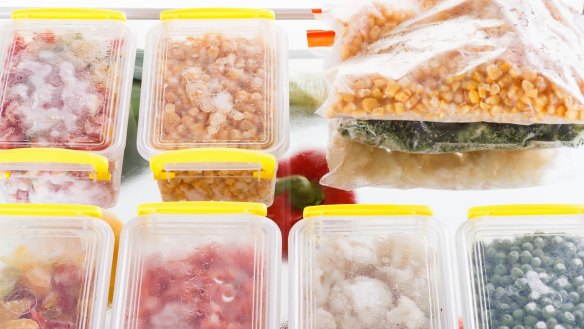
With the bounty of the autumn harvest upon us right now, this is the best time of the year to be making the most of the freshest, tastiest, most affordable and nutritious produce. By properly preparing fruit, vegetables, meat, fish, poultry, stock, soups and entire meals you can make the most of great value foods and stock the freezer with a supply of ingredients and ready-to-heat meals.
Your freezer runs at around -18°C. At this low temperature the processes of decay become glacially slow, bacteria become inactive and as a result food can remain edible for a long time. However, during freezing water in food turns to ice. The formation of ice crystals ruptures the cell walls of food, which explains why vegetables wilt after freezing and why meat becomes more tender. The slower the freezing, the larger the ice crystals, which causes more damage to cells. So it is best to freeze foods in smaller-size portions – the greater the surface area, the faster the food freezes.
Fat in food naturally oxidises, and while freezing slows this process down it does not stop it. Oxidised fat tastes rancid, and while safe to eat, it is not that pleasant to do so. So, this limits the time that meat, poultry and fish can be frozen before their eating quality is diminished.
What are the best foods to freeze?
Vegetables
Peas, beans, diced carrot, cauliflower and broccoli florets, corn kernels, baby corn and diced sweet potato can be frozen.
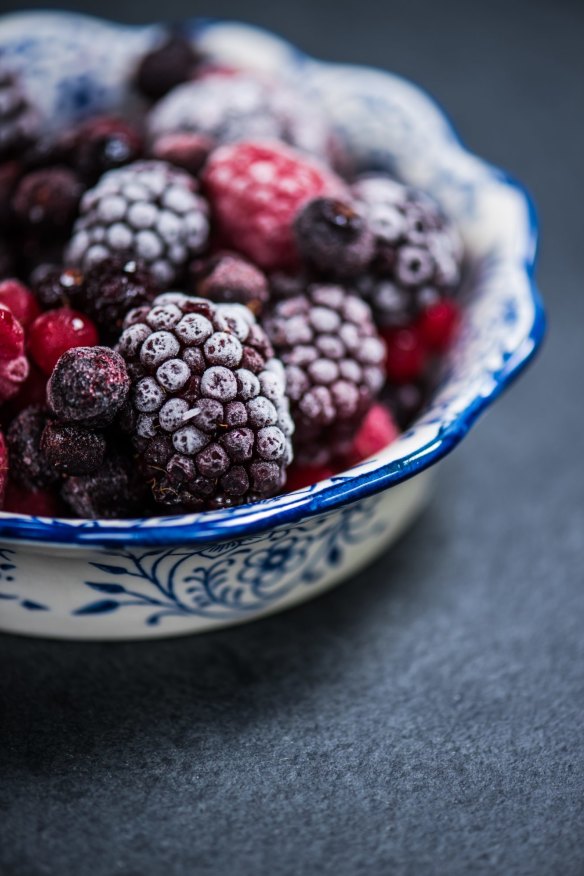
Freezing, however, only slows down but does not stop naturally occurring enzymes that cause vegetable cells to break down. Brief exposure to heat de-activates these enzymes. Therefore, vegetables should be blanched very briefly in boiling water then refreshed in chilled water. Drain briefly and spread out on a tray covered in baking paper and freeze. When frozen, take out of the freezer and place in a plastic freezer bag, remove as much air as possible, return to freezer.
Tomatoes can be done slightly differently: wash and de-stem them and puree in a food processor then freeze in amounts suitable for use in soups sauces and slow cooked dishes.
Fruit
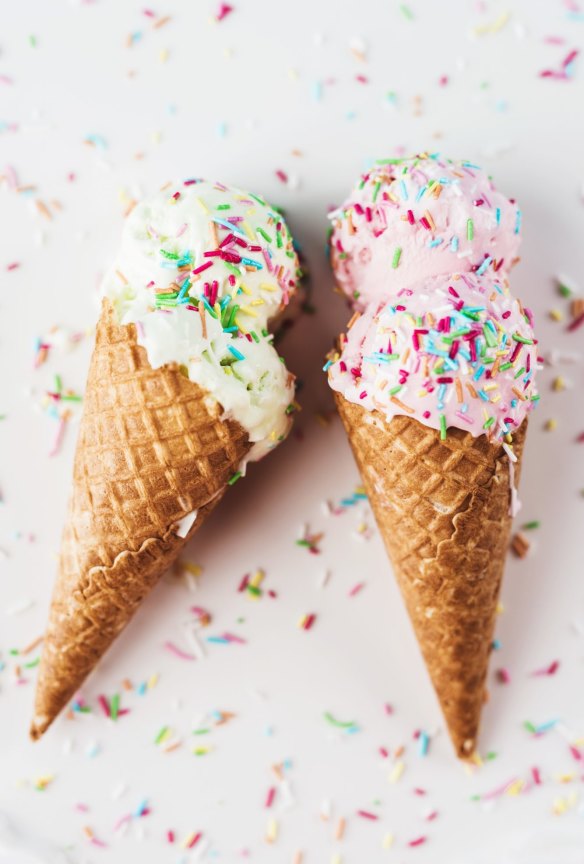
Fruit's fresh flavour preserves well, but not the texture. Fruit is around 95 per cent water and most fruits have thin skins and become mushy when frozen. However, they are perfect for smoothies, coulis, cooking and, very importantly, margaritas. Frozen fruit can be used in smoothies and fruit cocktails straight from the freezer in place of ice.
Freeze whole bananas in skins and use to make banana bread and smoothies. Apples can be peeled, sliced, frozen, placed in airtight containers and used in pies or crumble. Alternatively, stew with sugar and use to top porridge or muesli. Freeze pears, apricots and plums this same way.
Small whole fruit such as blackberries and blueberries freeze well, as do cherries, diced mango, pineapple, sliced kiwi, peaches, strawberries and nectarines. Lay berries and evenly sized pieces of cut fruit on a tray lined with baking paper. Freeze and pack as outlined with vegetables above.
Meat
Many cuts of meat are now vacuum-sealed in high-density plastic bags to improve shelf life. These packs of raw beef, lamb and pork are perfect for freezing as the plastic protects the meat completely from freezer burn.
Alternatively, tightly wrap meat in several layers of plastic film or place in sandwich bags with press seals and press the air from them before sealing. If you have a vacuum sealer, this is perfect to prepare meat for freezing.
Minced meat can be frozen in the plastic trays they are sold in. Whole legs and joints can be wrapped tightly in plastic film, but meat with the bone in does take up more space than butchered meat.
Poultry
A tightly wrapped whole chook will last a year in the freezer. Turkey will be good for seven months and duck, with its high fat content, six months. Portions should be treated as per meat (above).
Fish should be cleaned, scaled and the gills removed. You can tightly wrap or vacuum seal whole fish or fillets laid out in a single layer. To firm up white fish, lightly brine in 1 litre of water in which ¼ cup of salt has been dissolved. You can slow down the oxidisation of fatty fish by dipping in 1 litre of water in which 2 tablespoons of ascorbic acid (vitamin C) has been dissolved.
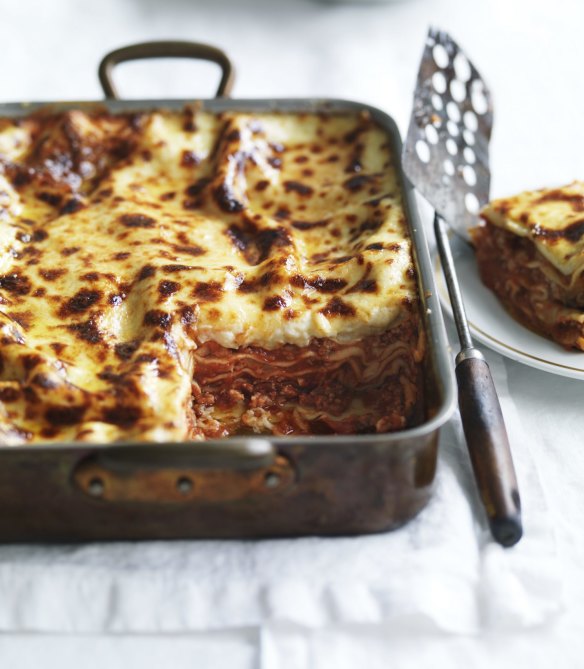
Cooked meals
Wet dishes, like soup, stews and casseroles, freeze well in airtight containers or can be frozen flat in plastic bags to save space.
When freezing a meal, such as meat and three veg, avoid freezer burn by following what frozen meal companies do. They slather their meals in a layer of very thick gravy or cheese sauce. This makes a protective blanket and reheats well in the microwave.
The crisp veg in stir fries will go limp if frozen but pasta sauces and curries freeze well.
Freeze unbaked lasagne, thaw and cook as needed. It will have better texture and be fresher tasting than a lasagne that is cooked twice. Similar with dishes topped with breadcrumbs, such as a tuna bake. Prepare, freeze, thaw and then cook in the oven. It will be tastier, and the breadcrumbs will be crisp on top.
Dairy
Freeze milk in plastic bottles but first pour off 10 per cent so there is room for the milk to expand as it freezes.
If the thawed milk develops a granular texture, use a stick blender to bring the fat and liquid together again.
Cream freezes well in the plastic bottle or container then can be thawed in the fridge for 24 hours before using. Freeze butter in the plastic-lined foil it is wrapped in. If butter is sold in paper parchment, wrap tightly in plastic film, as paper is permeable and the butter could take on other aromas in the freezer.
Pasta, rice, grains
Slightly undercook pasta, freeze, thaw and reheat in the sauce in which it is to be served. It will finish cooking in the sauce.
Short grain rice freezes better than long grain rice and, again, rice that is to be reheated after thawing should be ever so slightly underdone before freezing. Cooked quinoa, barley and other grains freeze well.
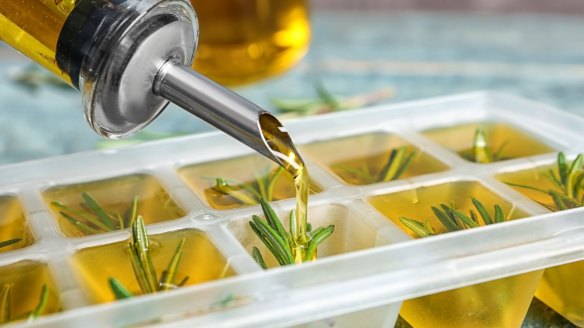
Herbs
Finely chop herbs, pack into a small ice cube tray, cover with oil or water and freeze. Use the frozen herb ice cubes directly in cooking.
Stock
Make stock as per your chosen recipe. Remove the bones and vegetables. To save space, cook further to reduce by 80 per cent to 90 per cent. Cool. Skim. Pour into a container or bags. Freeze.
Bread
Frozen bread is a great standby for toast and toasties. Cooling bread changes the structure of the starch and stales it. Sliced thawed bread it best toasted or whole rolls or loaves can be revived by running under the tap, and reheating in moderate oven for 10 minutes. Serve warm.
Eggs
Thawed eggs cook as well as fresh eggs. You can't freeze whole eggs without splitting the shells open so crack the eggs into a muffin tray or large cocktail ice cube tray. Freeze. Remove the frozen eggs and place in a freezer bag and return to freezer.
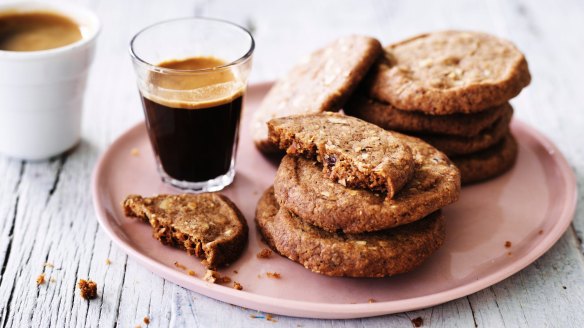
Baked goods
When it comes to freezing, sugar is your friend. Sugar helps keep cakes' texture. Sugar, however, can also pick up other aromas, so make sure baked cakes are tightly sealed. Do not freeze cakes that are iced or filled. Fruit, such as in an apple cake, will lose moisture and cause the crumb to become soggy.
While biscuits can be frozen, consider rolling biscuit dough into a log using baking paper, pre-slice into biscuit portions, wrap in plastic film, freeze. Bake the biscuit dough straight from the freezer.
Buttery pastries freeze well but need to be used within four months as the butter will oxidise.
How long does frozen food last?
The Russians in Siberia have been known to cook and eat woolly mammoth pulled from the permafrost. And while it probably didn't taste as good as it did during the Ice Age, it was still edible. Textures change over time, flavours become dull and fat becomes rancid.
Therefore, as a rough guideline, fatty foods like bacon and sausages are best before the end of three months. Butter should be used within four months, the same with fatty fish like mackerel, sardines and salmon.
Soups and sauces are best within three months, buttery pastries four months and the same with minced meat. Cooked dishes such as stews and pies are best within four months.
Bread is good for six months, as are cakes, stock and fruit juice. Use lamb, pork, chicken pieces (as opposed to a whole chicken, which can last longer), turkey and game within six months.
Frozen fruit pieces and berries are good for eight months, as is white fish, while stewed fruit, blanched vegetables, a whole chook or a tightly wrapped steak will last a year.
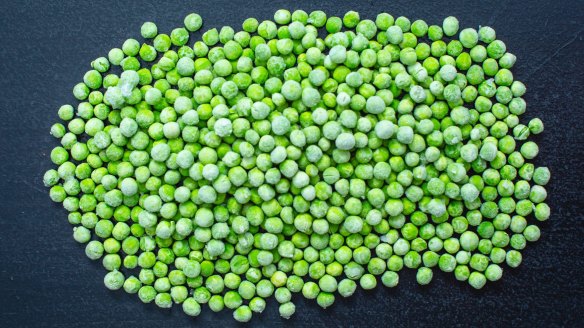
Is frozen food less nutritious?
Frozen food can be more nutritious than fresh food. Freshly harvested snap-frozen peas have better flavour and texture than raw peas in the pod that may have been sitting on a supermarket shelf for several days.
Blanching vegetables can knock C and B vitamins around but freezing does not greatly diminish the nutrition of food and can, in fact, improve the quality of fibre for digestion.
Is the flavour of frozen foods compromised?
Some aroma, especially high end notes from essential oils in spices and fresh herbs, is lost during freezing.
Do some things taste better after freezing?
Yes, ice-cream tastes better.
Do I need to chill food before freezing?
The Australian Food Safety Information Council recommends that hot food should be cooled on the bench "only until it stops steaming". Place the food directly into the container, cover with a lid and put it in the freezer.
How do you prevent freezer burn?
If food is exposed to the very cold air inside your freezer, the frozen water will migrate to the outside of the food and, in a process called sublimation, turn into water vapour. This causes freezer burn, unsightly patches on a steak for example, that affects the quality of eating. To avoid, wrap food tightly with plastic film or place in vacuum-sealed plastic bags.
What should you not freeze?
Vegetables you enjoy crisp such as celery, lettuce, cucumber and radishes will end up as mush.
Water expands by 11 per cent when it turns to ice so never freeze anything in glass, or non freezer-proof porcelain. Always leave enough space for liquid in food to expand when the water turns to ice.
Juice citrus and freeze the juice but don't freeze the entire fruit.
While hard cheese such as parmesan and pecorino can handle freezing, the high water content of soft cheeses such as brie and camembert will cause the texture to be ruined.
Tips
- Freeze raw food in portions you would normally cook with to prepare a dish. Freeze prepared food in portion sizes that you would normally feed to your household.
- Label food with name and date it was placed in the freezer. (Or best-by date, if you prefer)
- Food laid out flat will freeze faster than food in a container or in a big lump.
- Square containers are more space efficient that round containers.
- A clean freezer devoid of built-up ice is the most efficient. If necessary, de-frost your freezer. Freezers with good, intact seals will use less energy and keep a lower temperature.
- If the power goes off, the food in a full freezer should remain frozen for 48 hours. If the power goes out open the door as little as possible. Free-standing freezers can be covered in blankets or a doona to insulate it further.
Thawing
The safest way to thaw is to place frozen food on a plate and allow it to slowly thaw in the fridge for 24 hours (48 hours for large items such as meat joints or frozen poultry).
Do not defrost food on the kitchen bench, says the Australian Food Safety Information Council. They also recommend using the defrost setting on some microwave ovens.
It is possible to thaw foods rapidly in a bath of warm water, but this will not help the texture of the food, especially seafood.
Appears in these collections
The best recipes from Australia's leading chefs straight to your inbox.
Sign up- More:
- How to
